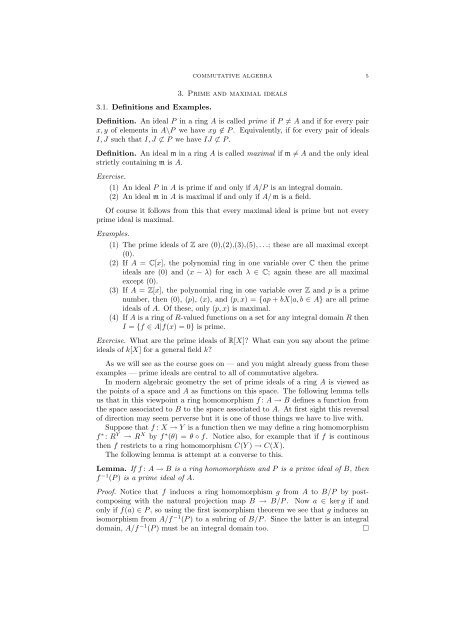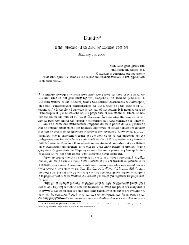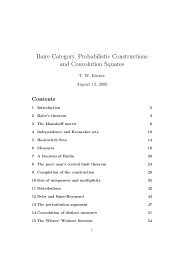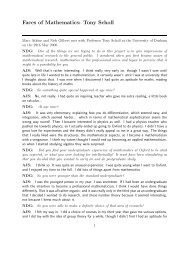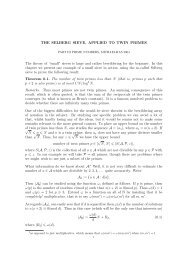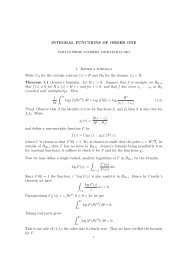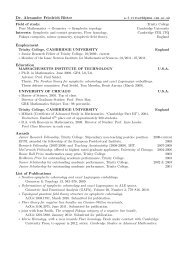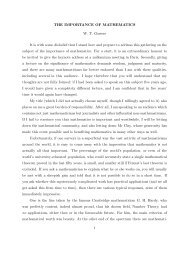3. Prime and maximal ideals 3.1. Definitions and Examples ...
3. Prime and maximal ideals 3.1. Definitions and Examples ...
3. Prime and maximal ideals 3.1. Definitions and Examples ...
You also want an ePaper? Increase the reach of your titles
YUMPU automatically turns print PDFs into web optimized ePapers that Google loves.
<strong>3.</strong>1. <strong>Definitions</strong> <strong>and</strong> <strong>Examples</strong>.<br />
COMMUTATIVE ALGEBRA 5<br />
<strong>3.</strong> <strong>Prime</strong> <strong>and</strong> <strong>maximal</strong> <strong>ideals</strong><br />
Definition. An ideal P in a ring A is called prime if P �= A <strong>and</strong> if for every pair<br />
x, y of elements in A\P we have xy �∈ P. Equivalently, if for every pair of <strong>ideals</strong><br />
I, J such that I, J �⊂ P we have IJ �⊂ P.<br />
Definition. An ideal m in a ring A is called <strong>maximal</strong> if m �= A <strong>and</strong> the only ideal<br />
strictly containing m is A.<br />
Exercise.<br />
(1) An ideal P in A is prime if <strong>and</strong> only if A/P is an integral domain.<br />
(2) An ideal m in A is <strong>maximal</strong> if <strong>and</strong> only if A/ m is a field.<br />
Of course it follows from this that every <strong>maximal</strong> ideal is prime but not every<br />
prime ideal is <strong>maximal</strong>.<br />
<strong>Examples</strong>.<br />
(1) The prime <strong>ideals</strong> of Z are (0),(2),(3),(5), . . .; these are all <strong>maximal</strong> except<br />
(0).<br />
(2) If A = C[x], the polynomial ring in one variable over C then the prime<br />
<strong>ideals</strong> are (0) <strong>and</strong> (x − λ) for each λ ∈ C; again these are all <strong>maximal</strong><br />
except (0).<br />
(3) If A = Z[x], the polynomial ring in one variable over Z <strong>and</strong> p is a prime<br />
number, then (0), (p), (x), <strong>and</strong> (p, x) = {ap + bX|a, b ∈ A} are all prime<br />
<strong>ideals</strong> of A. Of these, only (p, x) is <strong>maximal</strong>.<br />
(4) If A is a ring of R-valued functions on a set for any integral domain R then<br />
I = {f ∈ A|f(x) = 0} is prime.<br />
Exercise. What are the prime <strong>ideals</strong> of R[X]? What can you say about the prime<br />
<strong>ideals</strong> of k[X] for a general field k?<br />
As we will see as the course goes on — <strong>and</strong> you might already guess from these<br />
examples — prime <strong>ideals</strong> are central to all of commutative algebra.<br />
In modern algebraic geometry the set of prime <strong>ideals</strong> of a ring A is viewed as<br />
the points of a space <strong>and</strong> A as functions on this space. The following lemma tells<br />
us that in this viewpoint a ring homomorphism f : A → B defines a function from<br />
the space associated to B to the space associated to A. At first sight this reversal<br />
of direction may seem perverse but it is one of those things we have to live with.<br />
Suppose that f : X → Y is a function then we may define a ring homomorphism<br />
f ∗ : R Y → R X by f ∗ (θ) = θ ◦ f. Notice also, for example that if f is continous<br />
then f restricts to a ring homomorphism C(Y ) → C(X).<br />
The following lemma is attempt at a converse to this.<br />
Lemma. If f : A → B is a ring homomorphism <strong>and</strong> P is a prime ideal of B, then<br />
f −1 (P) is a prime ideal of A.<br />
Proof. Notice that f induces a ring homomorphism g from A to B/P by postcomposing<br />
with the natural projection map B → B/P. Now a ∈ kerg if <strong>and</strong><br />
only if f(a) ∈ P, so using the first isomorphism theorem we see that g induces an<br />
isomorphism from A/f −1 (P) to a subring of B/P. Since the latter is an integral<br />
domain, A/f −1 (P) must be an integral domain too. �
6 COMMUTATIVE ALGEBRA<br />
Note that the above lemma isn’t true if we replace the word prime by <strong>maximal</strong><br />
everywhere. For example if we consider the inclusion ι : Z → Q then (0) is a<br />
<strong>maximal</strong> ideal in Q but ι −1 (0) = (0) is not <strong>maximal</strong> in Z.<br />
If we want to put prime <strong>ideals</strong> at the centre of commutative algebra then an<br />
obvious question to ask is ‘must a ring have any prime <strong>ideals</strong>?’<br />
In order to demonstrate that the answer to this question is positive, we need to<br />
recall Zorn’s lemma.<br />
Zorn’s Lemma. If (S, ≤) is a partially ordered set such that every chain C in S<br />
has an upper bound in S then for every element x in S there is a <strong>maximal</strong> element<br />
y in S with x ≤ y.<br />
This result follows from the Axiom of Choice. Indeed, as those who know what<br />
the Axiom of Choice is will probably already know, in the usual axiomatisation of<br />
set theory the two are equivalent. As a result, we will assume the Axiom of Choice<br />
holds.<br />
Now we can prove,<br />
Theorem. If A is a ring <strong>and</strong> I an ideal of A such that I �= A, then A contains a<br />
<strong>maximal</strong> ideal m such that I ⊂ m.<br />
Note that if A isn’t the zero ring then I = (0) is an ideal not equal to A so it<br />
follows from this that there is always at least one <strong>maximal</strong> ideal.<br />
Proof. Let A be the set of <strong>ideals</strong> of A not equal to A, ordered by inclusion. We<br />
must show that whenever C is a chain in A it has an upper bound in A, since then<br />
the result follows immediately from Zorn. So let’s take such a chain C.<br />
Let I = �<br />
J∈C J. Now suppose x1, x2 are in I. Then there are J1, J2 in C such<br />
that xi ∈ Ji. Either J1 ⊂ J2 or J2 ⊂ J1; WLOG the former. Then x1 ∈ J2, so<br />
x1 + x2 ∈ J2 ⊂ I. Also if a ∈ A then axi ∈ J2 ⊂ I for each i. It follows that I is<br />
an ideal.<br />
It now just remains to check that I �= A. But 1 �∈ J for each J ∈ C, so 1 �∈ I <strong>and</strong><br />
I �= A as required. �<br />
Once we have defined Noetherian rings, it will be apparent that we do not need<br />
Zorn’s lemma to prove this result for that important class of rings.<br />
Corollary. Every non-unit lies in a <strong>maximal</strong> ideal.<br />
Proof. If x is a non-unit then (x) �= A �<br />
Consider the ring C(x) of rational functions { f(x)<br />
g(x) |g �= 0} on C. And let A be<br />
the subring of C(x) consisting of those functions with no pole at 0 ie { f<br />
g<br />
|g(0) �= 0}.<br />
We may consider A as ‘polynomial functions on C defined “near” 0’.<br />
Now f is a unit in A precisely if f(0) �= 0, <strong>and</strong> the set of non-units of A form<br />
an ideal: the kernel of evaluation at 0. We will see in a moment that this is the<br />
unique <strong>maximal</strong> ideal of A.<br />
Definition. A ring A with precisely one <strong>maximal</strong> ideal m is called a local ring. In<br />
this case that field A/ m is called the residue field of A.
COMMUTATIVE ALGEBRA 7<br />
Proposition. A ring A is local if <strong>and</strong> only if the set of non-units in A form an<br />
ideal in A.<br />
Proof. Suppose that A is local. Then since every non-unit lies in a <strong>maximal</strong> ideal<br />
<strong>and</strong> there is only one <strong>maximal</strong> ideal m, they must all lie in m. Moreover m cannot<br />
contain any units since then m would have to be the whole of A. So m is the set of<br />
non-units in A.<br />
Conversely, suppose that the set of non-units in A form an ideal I, <strong>and</strong> J is any<br />
ideal not equal to A. Then J again cannot contain any units so J ⊂ I <strong>and</strong> I is the<br />
unique <strong>maximal</strong> ideal. �<br />
Corollary. Let A be a ring with <strong>maximal</strong> ideal m. If every element of 1 + m is a<br />
unit, then A is a local ring.<br />
Proof. Let x ∈ A\ m. Since m is <strong>maximal</strong>, the smallest ideal containing m <strong>and</strong> x is<br />
A. It follows that 1 = ax + y for some a ∈ A <strong>and</strong> y ∈ m. Then ax = 1 − y is a unit<br />
by assumption <strong>and</strong> so m contains all the non-units. �<br />
<strong>3.</strong>2. The prime spectrum.<br />
Definition. Given a ring A we define Spec(A) to be the set of all prime <strong>ideals</strong> of<br />
A. We also define maxSpec(A) to be the set of all <strong>maximal</strong> <strong>ideals</strong> of A.<br />
We want to put a topology on these spaces. To this end, for each subset S of<br />
A we define V (S) to be the set of prime <strong>ideals</strong> of A containing S. These will be<br />
the closed sets of Spec(A). We will then give maxSpec(A) the subspace topology.<br />
We’ll call these the Zariski topology.<br />
The following lemma will convince us that this does indeed define a topology:<br />
Lemma. (i) If I is the smallest ideal containing S then V (S) = V (I);<br />
(ii) V ({0}) = Spec(A),V ({1}) = ∅;<br />
(iii) if (Eγ)γ∈Γ is a family of subsets of A, then<br />
⎛<br />
V ⎝ �<br />
⎞<br />
⎠ = �<br />
V (Eγ);<br />
γ∈Γ<br />
Eγ<br />
γ∈Γ<br />
(iv) if I <strong>and</strong> J are <strong>ideals</strong> in A then V (I ∩ J) = V (I) ∪ V (J).<br />
Note that (ii) tells us that Spec(A) <strong>and</strong> the empty set are closed, (iii) that the<br />
closed sets are closed under arbitrary intersections <strong>and</strong> (iv) together with (i) that<br />
they are closed under finite unions. We call the topology on Spec(A) with these<br />
closed sets the Zariski topology.<br />
Proof. (i) Since S ⊂ I it is clear that V (I) ⊂ V (S). If any ideal contains S then it<br />
also contains I <strong>and</strong> so V (S) ⊂ V (I).<br />
(ii) <strong>and</strong> (iii) are clear from the definition.<br />
(iv) Every ideal containing either I or J must contain I ∩ J, <strong>and</strong> so we have<br />
V (I) ∪ V (J) ⊂ V (I ∩ J). Suppose that P ∈ Spec(A) <strong>and</strong> I ∩ J ⊂ P then IJ ⊂ P<br />
so by primality of P either I ⊂ P or J ⊂ P. �<br />
Exercise. Draw pictures of Spec(C[x]), Spec(R[x]) <strong>and</strong> Spec(Z).<br />
Recall that N(A) is the ideal consisting of all nilpotent elements of A.<br />
Proposition. The nilradical of A is the intersection of all the prime <strong>ideals</strong> of A.
8 COMMUTATIVE ALGEBRA<br />
Note this means that V (S) = Spec(A) if <strong>and</strong> only if S ⊂ N(A). In particular<br />
there is a natural bijection Spec(A) ↔ Spec(A/N(A)).<br />
Proof. Suppose that f ∈ N(A), so f n = 0 for some positive integer n. Now if P is<br />
any ideal then f n ∈ P so if P is prime then f n−1 is in P or f is in P. Inductively<br />
we see that in either case f is in P. It follows that f is in every prime ideal <strong>and</strong><br />
N(A) is contained in the intersection of all prime <strong>ideals</strong>.<br />
Conversely, suppose f isn’t nilpotent, <strong>and</strong> consider the set A of <strong>ideals</strong> I in A<br />
such that f n is not in I for every positive integer n. Since f isn’t nilpotent, (0) is<br />
in A <strong>and</strong> so by Zorn A has a <strong>maximal</strong> element I0.<br />
We claim that I0 is prime. Suppose a, b are in A\I0. Then there is an n such<br />
that f n is in the ideal I0 + (a) <strong>and</strong> an m such that f m is in I0 + (b). It follows that<br />
f n+m ∈ I0 + (ab). By definiton of I0 this must be strictly bigger than I0 <strong>and</strong> so ab<br />
is not an element of I0 <strong>and</strong> the claim holds.<br />
Since f is not in I0, it now follows that f is not in the intersection of all prime<br />
<strong>ideals</strong> <strong>and</strong> so N(A) contains the intersection of all prime <strong>ideals</strong> as required. �<br />
Definition. Given any ideal I of A, we define the radical of I,<br />
√ I = {x ∈ A|x n ∈ I for some n > 0} = π −1 (N(A/I))<br />
Corollary. The radical of an ideal of I is the intersection of all the prime <strong>ideals</strong><br />
containing I.<br />
Proof. We just apply the previous proposition to the ring A/I. �<br />
We see from this that for any ideal I we have V (I) = V ( √ I).<br />
Also of interest later will be the Jacobson radical of a ring:<br />
Definition. Let A be a non-zero ring then the Jacobson radical of A, Jac(A), is<br />
the intersection of all <strong>maximal</strong> <strong>ideals</strong> of A.<br />
Note that always N(A) ⊂ Jac(A). We will see later that algebraically Hilbert’s<br />
famous Nullstellensatz says that for finitely generated algebras A over C we have<br />
N(A) = Jac(A).<br />
We can characterise the Jacobson radical as follows:<br />
Lemma. Jac(A) = {a ∈ A|1 − ax is a unit in A for all x ∈ A}.<br />
Proof. If a ∈ Jac(A) <strong>and</strong> 1 − ax is not a unit in A for some x ∈ A then 1 − ax<br />
is contained in some <strong>maximal</strong> ideal m of A (by the Zorn argument earlier). But a<br />
must also be an element of m so 1 − ax + ax = 1 ∈ a, a contradiction.<br />
Conversely if a �∈ Jac(A) then there is a <strong>maximal</strong> ideal m not containing a. Thus<br />
m + (a) = A <strong>and</strong> 1 = y + ax for some y ∈ m <strong>and</strong> x ∈ A. Thus 1 − ax ∈ m cannot<br />
be a unit. �<br />
Lemma. Let φ: A → B be a ring homomorphism, <strong>and</strong> write X = Spec(A) <strong>and</strong><br />
Y = Spec(B). Recall that if P ∈ Y then φ −1 (P) ∈ X, <strong>and</strong> write φ ∗ for the mapping<br />
from Y to X induced in this way. Then<br />
(i) φ ∗ is continuous.<br />
(ii) If φ is a surjection then φ ∗ is a homeomorphism onto V (kerφ). In particular<br />
Spec(A) <strong>and</strong> Spec(A/N(A)) are naturally homeomorphic.<br />
(iii) If ψ : B → C is also a ring homomorphism then (ψ ◦ φ) ∗ = φ ∗ ◦ ψ ∗ .
COMMUTATIVE ALGEBRA 9<br />
Proof. (i) it suffices to show that if I is an ideal in A then φ ∗−1 (V (I)) is closed in<br />
Y . Now V (I) is the set of prime <strong>ideals</strong> in A containing I, so a prime ideal P in B<br />
is in φ ∗−1 (V (I)) if <strong>and</strong> only if φ ∗ (P) contains I if <strong>and</strong> only if φ −1 (P) contains I if<br />
<strong>and</strong> only if P contains φ(I). So φ ∗−1 (V (I)) = V (φ(I)) which is closed as required.<br />
(ii) Suppose φ is a surjection. We may assume that B = A/ kerφ. Then the<br />
isomorphism theorems for rings give us a 1-1 order preserving correspondence between<br />
<strong>ideals</strong> of B <strong>and</strong> an <strong>ideals</strong> of A containing kerφ. Moreover this induces a<br />
correspondence between prime <strong>ideals</strong> of B <strong>and</strong> prime <strong>ideals</strong> of A containing kerφ<br />
this latter correspondence may be described by φ ∗ . Thus φ ∗ is a bijection from<br />
Spec(B) to V (kerφ). The order preserving property makes it easy to see that it is<br />
in fact a homeomorphism.<br />
(iii) This just follows from the fact that (ψ ◦ φ) −1 (Q) = φ −1 (ψ −1 (Q)) for each<br />
prime ideal Q in C. �<br />
Note for category theorists in the audience: the final part of this lemma tells<br />
us that we have a contravariant functor from rings <strong>and</strong> ring homomorphisms to<br />
topological spaces <strong>and</strong> continuous maps given by A maps to Spec(A) <strong>and</strong> φ maps<br />
to φ ∗ . This defines an equivalence of categories between (commutative) rings <strong>and</strong><br />
affine schemes [or rather its opposite].<br />
4.1. Free modules.<br />
4. Universal Properties<br />
Qn. What does it mean to say that a k-vector space V has a basis X?<br />
Answer (1). X ⊂ V is linearly independent <strong>and</strong> spans V .<br />
Answer (2). Alternatively, for every k-vector space W <strong>and</strong> every function f : X →<br />
W extends uniquely to a linear map α: V → W. (LI is loosely equivalent to extends<br />
<strong>and</strong> spans is equivalent to extends in at most one way).<br />
We might say that there is a canonical bijection {f : X → W } → Homk(V, W)<br />
for all k-vector spaces W.<br />
We know that two vector spaces with bases of the same cardinality are isomorphic.<br />
Why? If we have (X, V ) as above <strong>and</strong> (X ′ , V ′ ) another such pair <strong>and</strong> π: X → X ′<br />
is a bijection then by the above we have unique linear maps α: V → V ′ <strong>and</strong><br />
β : V ′ → V extending φ <strong>and</strong> φ −1 (there is an abuse of notation here but that<br />
should not concern us too much).<br />
But now βα: V → V is extending φ −1 φ = idX <strong>and</strong> so must be idV since this<br />
extends idX. Similarly αβ : V ′ → V ′ extends φφ−1 = idX ′ <strong>and</strong> so must be idV ′. So<br />
α <strong>and</strong> β are mutual inverses.<br />
Diagramatically, X � �<br />
��<br />
V�<br />
�<br />
φ<br />
∃!α<br />
�<br />
��<br />
��<br />
id X id<br />
��<br />
��<br />
′� �<br />
��<br />
φ −1<br />
V<br />
��<br />
′<br />
�<br />
�<br />
∃!β<br />
��<br />
�<br />
X � �<br />
��<br />
V<br />
Since the big rectangle commutes the identity must be the unique map that<br />
makes it commute but the two smaller squares commute so βα = id.
10 COMMUTATIVE ALGEBRA<br />
Now it is natural to change the defintion of a vector space with a basis slightly.<br />
Answer (3). If V is a k-vector space, we say an injection ι: X → V is a basis for<br />
V if for every k-vector space W <strong>and</strong> every function f : X → W, ∃! linear map<br />
g: V → W making<br />
X ι ��<br />
� V<br />
� �<br />
���<br />
�<br />
� g<br />
f ��<br />
�<br />
��<br />
��<br />
W<br />
commute.<br />
Identifying X <strong>and</strong> X ′ above under φ we have seen that if ι: X → V <strong>and</strong> ι ′ : X ′ →<br />
V ′ are bases for V <strong>and</strong> V ′ then there is a canonical isomorphism V → V ′ depending<br />
only on ι <strong>and</strong> ι ′ .<br />
Notice however:<br />
(i) in our discussion we have not shown that for every set X there is a vector<br />
space with basis X;<br />
(ii) we certainly haven’t shown that every vector space has a basis.<br />
But if we can prove (i) then we will be able to speak of ‘the vector space with<br />
basis X.’<br />
More generally,<br />
Definition. Suppose that A is a ring <strong>and</strong> X a set, we say an A-module A (X)<br />
(together with an injection ι: X → A (X) ) is the free A-module on X if for every<br />
A-module M <strong>and</strong> every function f : X → M there exists a unique A-module map<br />
α: A (X) → M making<br />
ι<br />
X ��<br />
� A<br />
���<br />
��<br />
f ����<br />
(X)<br />
�<br />
�<br />
∃!α<br />
��<br />
�<br />
M<br />
commute.<br />
We have seen that this definition characterises the pair (A (X) , ι) up to unique<br />
isomorphism if it exists. In fact {θ ∈ A X |θ(x) = 0 for all but finitely many x ∈ X}<br />
together with the function ι that sends x ∈ X to the characteristic function of x<br />
satisfies the universal property for a free module. So for every set X there is a free<br />
A-module on X. Of course not every A-module is free in general.<br />
4.2. Localisation. Algebraically, localisation involves inverting elements of a ring.<br />
Geometrically, this corresponds to concentrating on open subsets of our space.<br />
Example. C[x] corresponds to polynomial functions on C.<br />
(1) If we invert x we obtain C[x, x −1 ] which corresponds to polynomial functions<br />
on C\{0}.<br />
(2) If we invert all elements of C[x] not contained in (x) we get rational functions<br />
on C with no pole at 0 i.e. polynomial functions defined on a neighbourhood<br />
of 0 in C.<br />
(3) We may interpret C(x) as polynomial functions on the generic point (0) of<br />
Spec(C[x]).
COMMUTATIVE ALGEBRA 11<br />
The classical example of localisation is the construction of the rationals from the<br />
integers. In this case we invert all non-zero elements of Z. The goal of this section<br />
is to generalise this construction to inverting arbitrary subsets. But if we invert x<br />
<strong>and</strong> y then we have de facto inverted xy too. Thus<br />
Definition. Suppose that A is a ring. A subset S of A is called multiplicatively<br />
closed (m.c. for short) if 1 ∈ S <strong>and</strong> S is closed under multiplication.<br />
We aim to construct a new ring AS from A so that all elements of S become<br />
units in a <strong>maximal</strong>ly efficient way. In particular we want AS to satisfy:<br />
There is a ring homomorphism ι: A → AS such that<br />
• ι(s) is a unit in AS for all s ∈ S;<br />
• if g: A → B is a ring homomorphism such that g(s) is a unit in B for each<br />
s ∈ S then there exists a unique ring homomorphism h : AS → B such that<br />
the following diagram commutes<br />
ι<br />
A ��<br />
�<br />
h<br />
g �<br />
�<br />
��<br />
���<br />
B.<br />
By the argument used for free modules if such a pair (AS, ι) exists then it does<br />
so uniquely up to unique isomorphism.<br />
We now explain how to construct such a ring: first we define an equivalence<br />
relation on the set A × S by (a, s) ∼ (b, t) precisely if there is a u ∈ S such that<br />
(at − bs)u = 0 for some u ∈ S.<br />
Lemma. This is an equivalence relation.<br />
Proof. Reflexivity <strong>and</strong> symmetry are evident. We need to check transitivity: suppose<br />
(a, s) ∼ (b, t) ∼ (c, u) so there are v, w in S such that (at−bs)v = (bu−ct)w =<br />
0. Then<br />
AS<br />
atvuw = bsvuw = ctsvw<br />
so (au − cs)tvw = 0 <strong>and</strong> tvw ∈ S as required. �<br />
We write, with deliberate suggestiveness, a/s for the equivalence class containing<br />
(a, s) <strong>and</strong> AS for the set of equivalence classes.<br />
Notice that if S contains zero-divisors in A then we cannot prove transitivity<br />
of the more straightforward relation (a, s) ≈ (b, t) precisely if at = bs. If A is an<br />
integral domain then the two relations are the same.<br />
We still need to put a ring structure on AS. We do this using the usual ‘fractional<br />
calculus’; that is we define a/s + b/t = (at + bs)/st <strong>and</strong> (a/s)(b/t) = (ab)/(st).<br />
Dull Exercise. Show that these operations are independent of the choice of equivalence<br />
class representatives (a, s) <strong>and</strong> (b, t) <strong>and</strong> that they satisfy the axioms of a<br />
ring. Show, moreover, that the function ι : A → AS that maps a to a/1 is ring<br />
homomorphism. Finally kerι = {a ∈ A|as = 0 for some s ∈ S}.<br />
Notice ι need not be an injection: if as = 0 for some s ∈ S then a/1 = 0/1.<br />
Indeed kerι = {a ∈ A|as = 0 some s ∈ S}.


